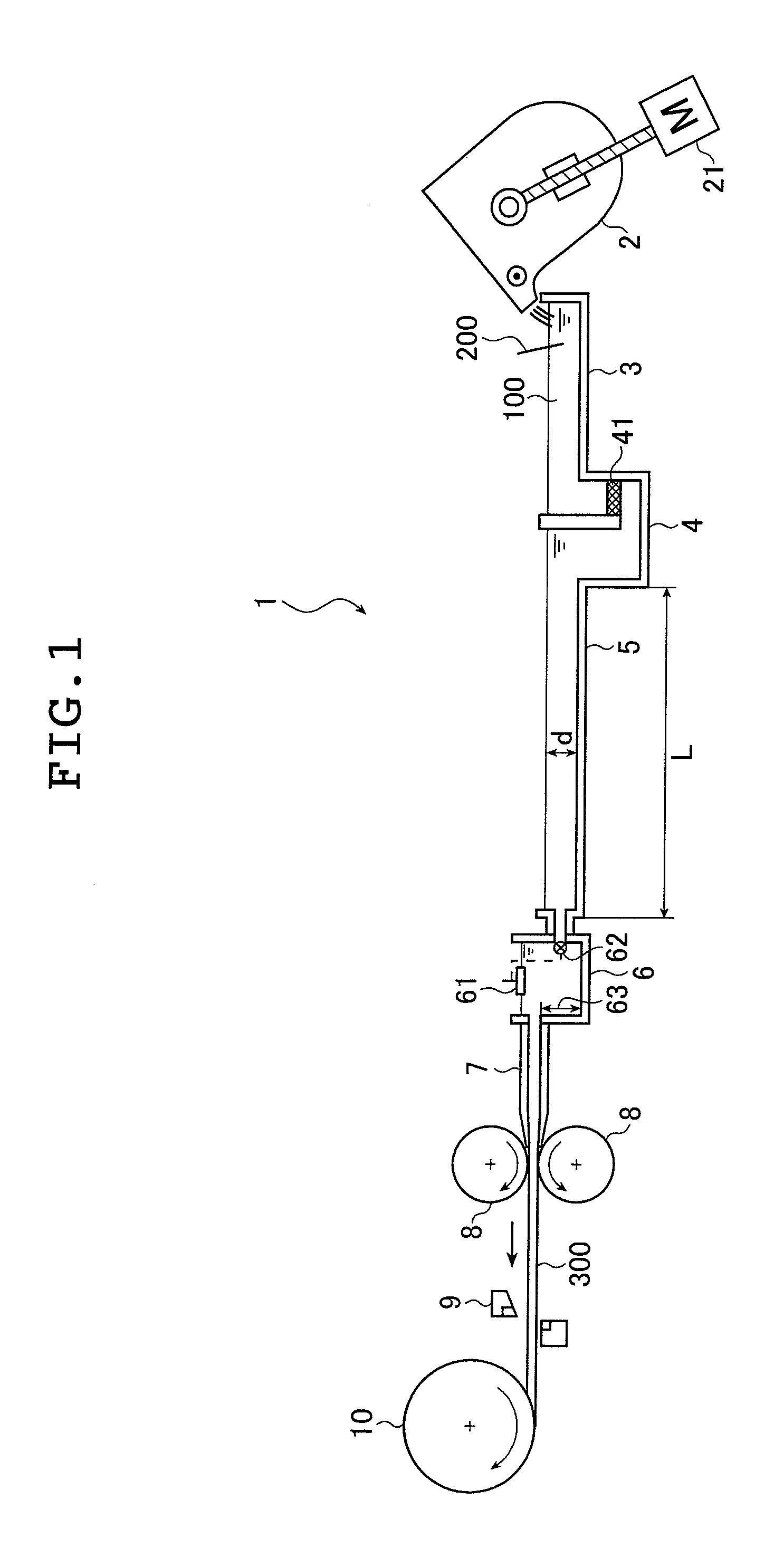Method and apparatus for manufacturing aluminum alloy strip for lithographic printing plates
a technology of lithographic printing plate and aluminum alloy, which is applied in the direction of manufacturing converters, printing form reproduction, furnaces, etc., can solve the problems that tibsub>2 /sub>particles having a particle size of 100 m or more cannot be completely eliminated, and the use of fine filtering means alone is not enough to prevent black streaks during casting for an extended period of time, so as to prevent the formation of black streaks
- Summary
- Abstract
- Description
- Claims
- Application Information
AI Technical Summary
Benefits of technology
Problems solved by technology
Method used
Image
Examples
example 1
[0147]A continuous cast strip (aluminum alloy strip) 300 was produced using the continuous casting and rolling apparatus 1 shown in FIG. 1.
[0148]A melt 100 prepared in the melting and holding furnace 2 to a composition of 0.3% iron, 0.1% silicon and 0.01% copper, with the balance being inadvertent impurities and aluminum, was poured into a first launder 3. During passage of the melt 100 through the first launder 3, grain refiner wire (diameter, 10 mm) 200 composed of 5% titanium and 1% boron, with the balance being aluminum and inadvertent impurities, was added thereto, bringing the titanium and boron contents within the melt 100 to 0.015% and 0.003%, respectively.
[0149]Degassing treatment was carried out with a degasser (not shown) provided on the first launder 3, and filtration treatment was carried out with a filtering means 4. A ceramic foam filter (thickness, about 50 mm; mesh size, 30 ppi) was used as the filter 41.
[0150]After passing through a second launder 5, a liquid level...
example 2
[0157]Next, the influences of the titanium and boron contents were investigated by carrying out casting at different titanium and boron contents in the melt 100.
[0158]Aside from changing the titanium and boron contents in the melt 100 following addition of the grain refiner wire (diameter, 10 mm) 200 to the three following sets of values, the same procedure was followed as in Example 1. The melt depth D in the second launder 5 was set to 0.15 m.
(Ti,B)=(0.06%,0.012%)(0.04%,0.01%)(0.025%,0.005%)
[0159]The results are shown in Table 1-2 below.
TABLE 1-2Launder passage time and number of black streaksTi content (%)0.060.040.0250.015B content (%)Passage time t0.0120.010.0050.003(seconds)0.10.150.2 0.25305233191040211595500000600000
[0160]As is apparent from the above results, at higher titanium and boron contents, when the launder passage time t is short, the incidence of black streaks rises. However, black streaks can be kept from arising by having the launder passage time t be longer tha...
examples 3 to 10
, Comparative Examples 1 to 8
[0161]Aside from changing the average flow velocity V (m / s) of the melt 100 in the second launder 5, the width (m) of the second launder 5, the melt depth D (m) in the second launder 5 and the length L of the second launder 5 in the manner shown in Table 3, the same procedure was carried out as in Example 1.
TABLE 3FlowLaunderMeltLaundervelocity Vwidthdepth Dlength LFormulaBlack(m / sec)(m)(m)(m)(2)streaksEX 30.0230.050.10.7satisfied0EX 40.0350.050.11satisfied0EX 50.0460.050.11.3satisfied0EX 60.0690.050.11.9satisfied0EX 70.0120.050.20.7satisfied0EX 80.0170.050.21satisfied0EX 90.0230.050.21.3satisfied0EX 100.0350.050.21.9satisfied0CE 10.0230.050.10.5not satisfied8CE 20.0350.050.10.8not satisfied5CE 30.0460.050.11.1not satisfied5CE 40.0690.050.11.7not satisfied4CE 50.0120.050.20.5not satisfied5CE 60.0170.050.20.8not satisfied3CE 70.0230.050.21.1not satisfied3CE 80.0350.050.21.7not satisfied2
PUM
| Property | Measurement | Unit |
|---|---|---|
| thickness | aaaaa | aaaaa |
| thickness | aaaaa | aaaaa |
| size | aaaaa | aaaaa |
Abstract
Description
Claims
Application Information
 Login to View More
Login to View More - R&D
- Intellectual Property
- Life Sciences
- Materials
- Tech Scout
- Unparalleled Data Quality
- Higher Quality Content
- 60% Fewer Hallucinations
Browse by: Latest US Patents, China's latest patents, Technical Efficacy Thesaurus, Application Domain, Technology Topic, Popular Technical Reports.
© 2025 PatSnap. All rights reserved.Legal|Privacy policy|Modern Slavery Act Transparency Statement|Sitemap|About US| Contact US: help@patsnap.com



